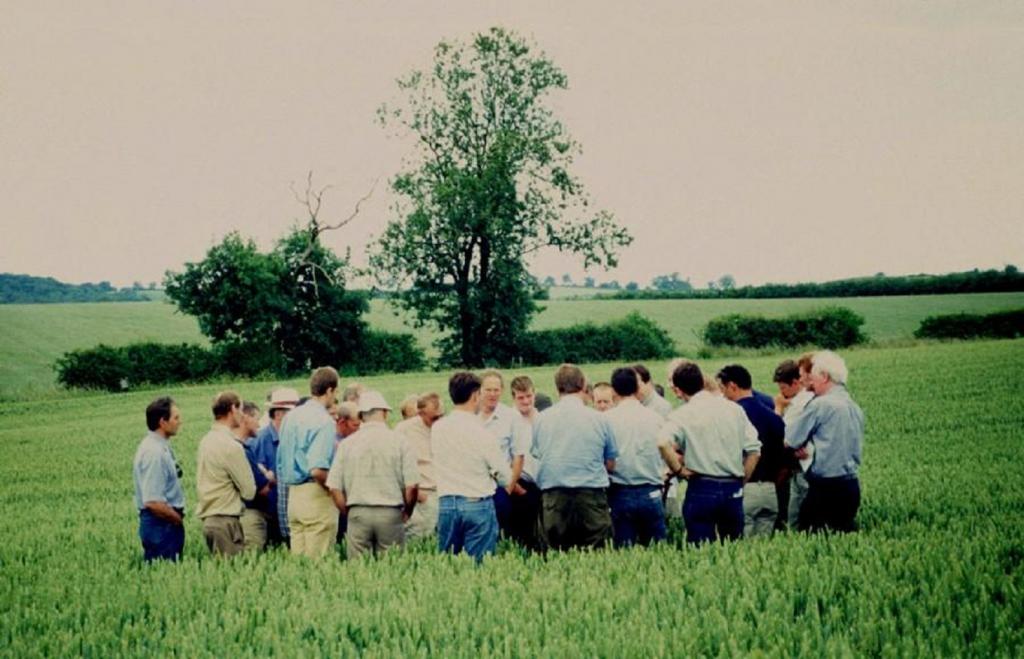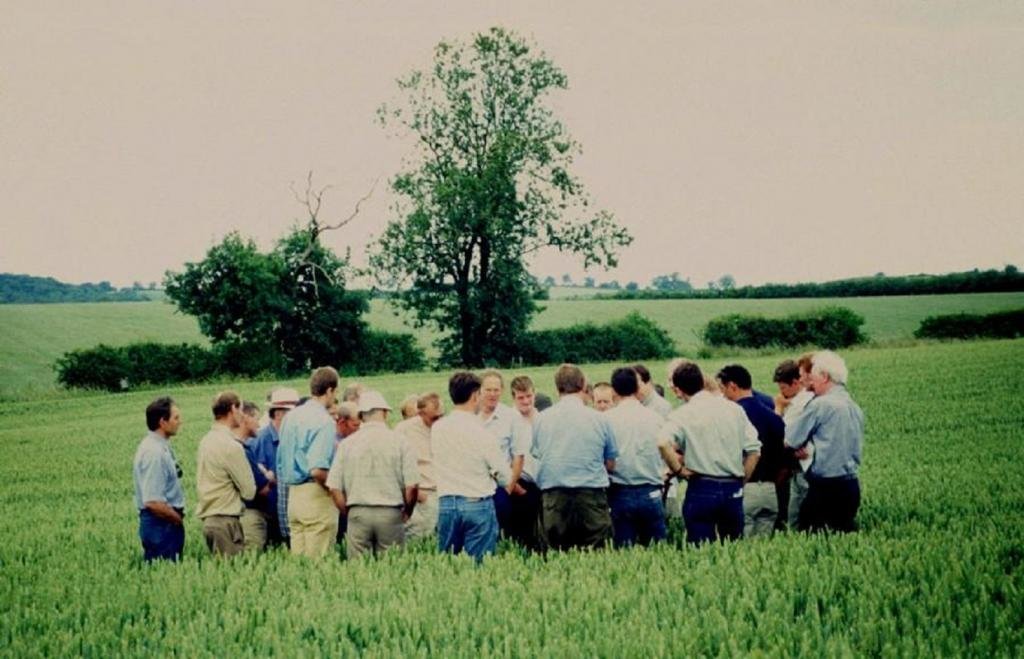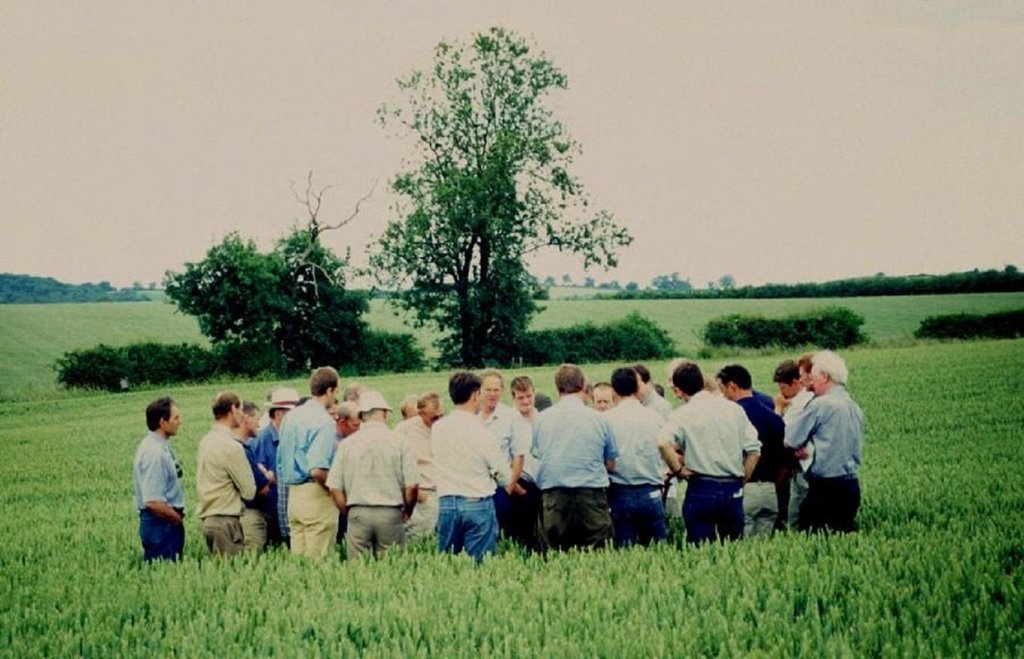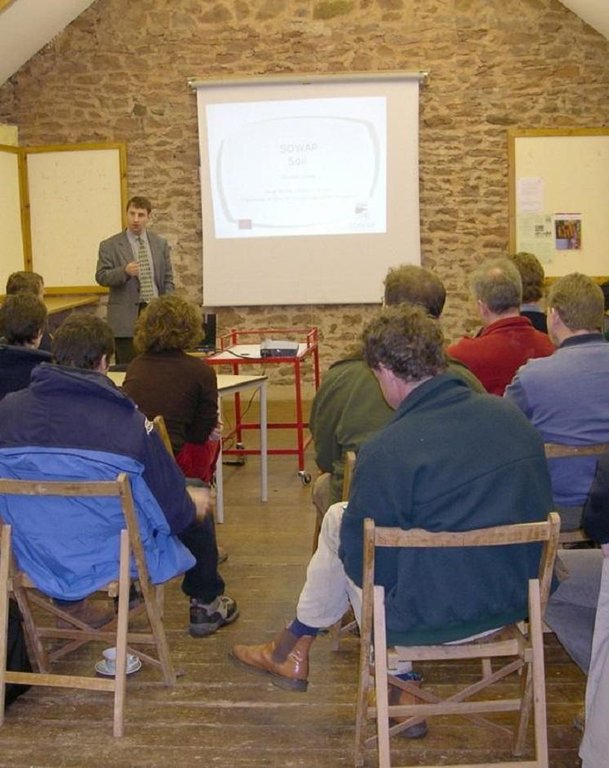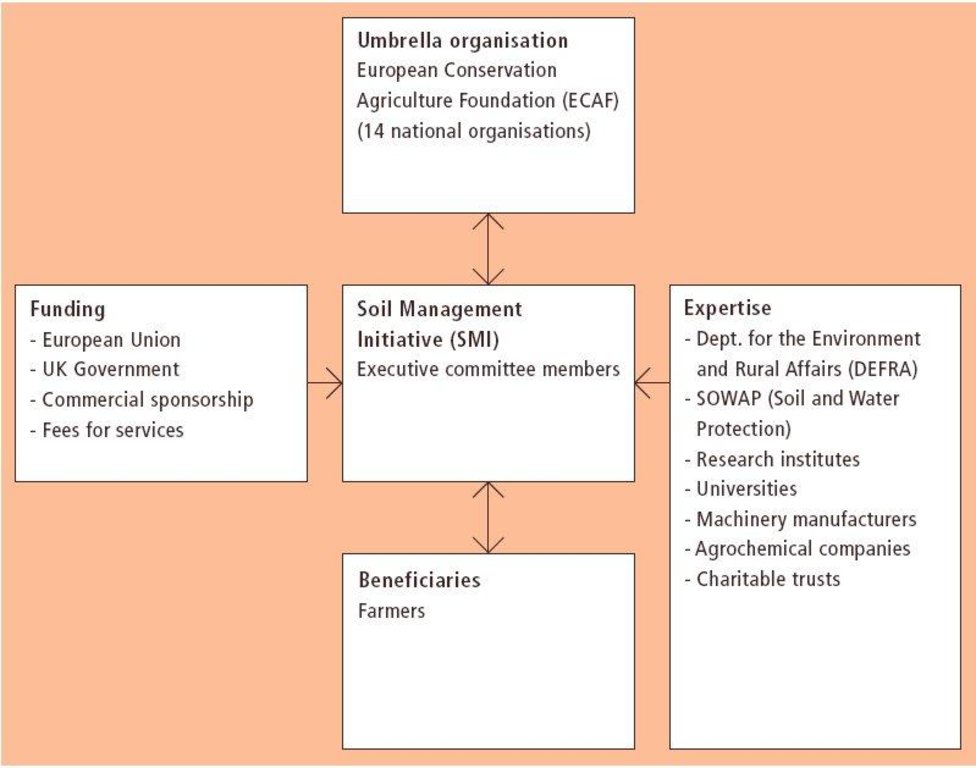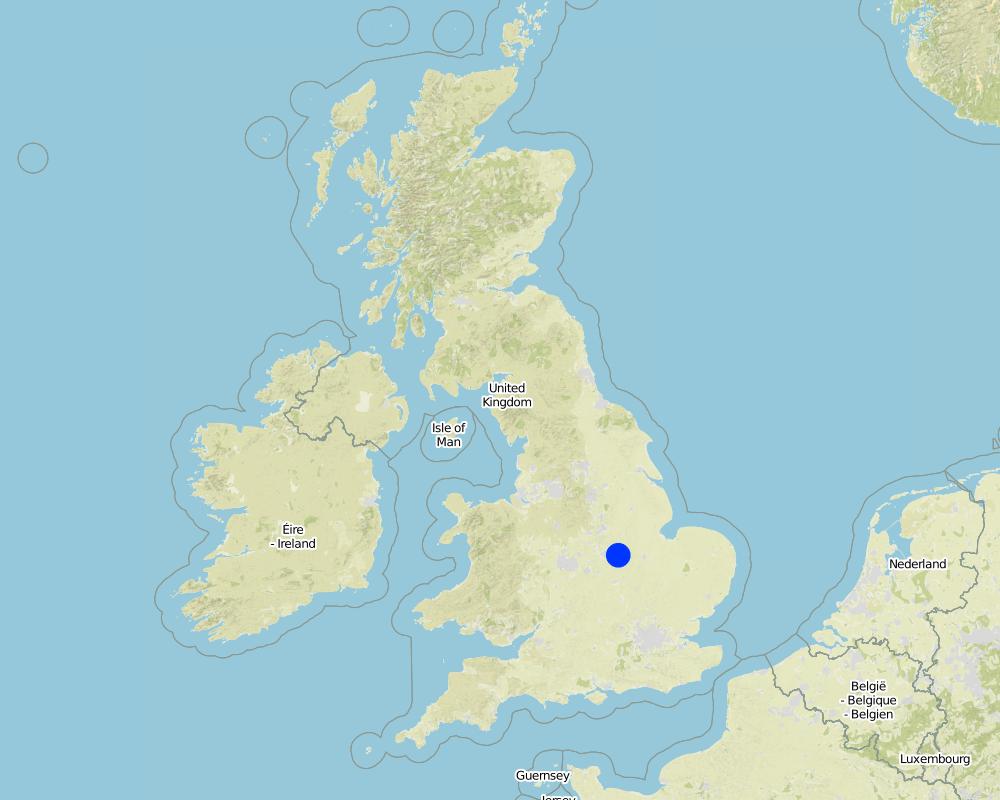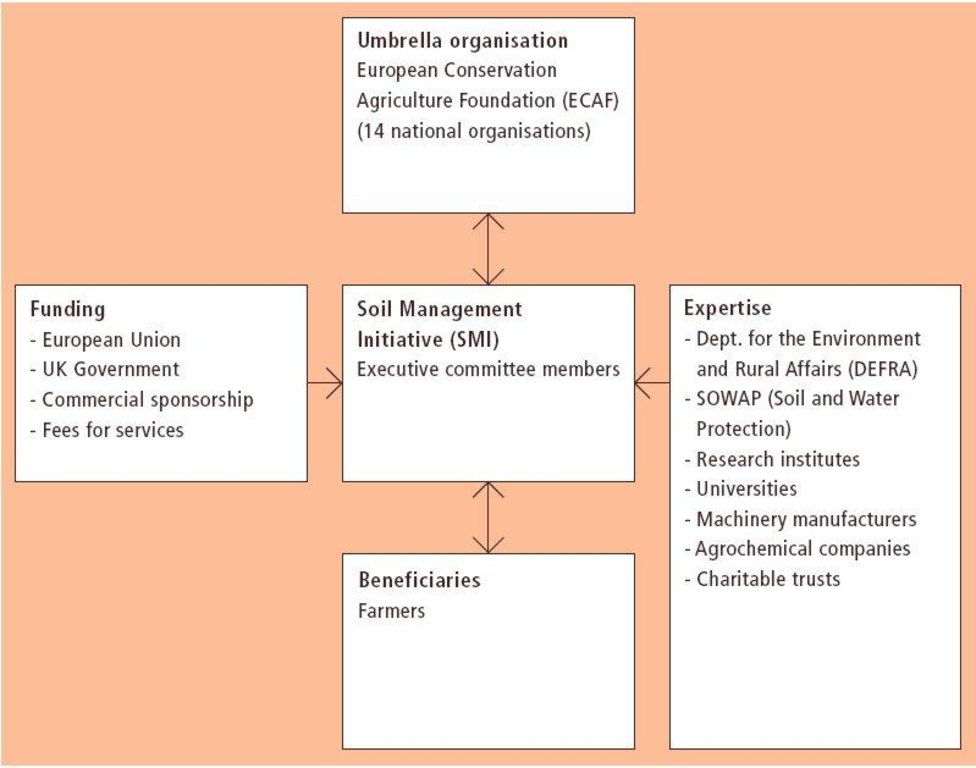Soil management initiative [ລາຊະອານາຈັກອັງກິດ]
- ການສ້າງ:
- ປັບປູງ:
- ຜູ້ສັງລວມຂໍ້ມູນ: Alastaire Leake
- ບັນນາທິການ: –
- ຜູ້ທົບທວນຄືນ: Fabian Ottiger, Alexandra Gavilano
approaches_2620 - ລາຊະອານາຈັກອັງກິດ
ເບິ່ງພາກສ່ວນ
ຂະຫຍາຍທັງໝົດ ຍຸບທັງໝົດ1. ຂໍ້ມູນທົ່ວໄປ
1.2 ລາຍລະອຽດ ການຕິດຕໍ່ ຂອງບຸກຄົນທີ່ຊັບພະຍາກອນ ແລະ ສະຖາບັນ ການມີສ່ວນຮ່ວມ ໃນການປະເມີນຜົນ ແລະ ເອກະສານ ຂອງວິທີທາງ
ຊື່ຂອງ ສະຖາບັນການຈັດຕັ້ງ ທີ່ອໍານວຍຄວາມສະດວກ ໃນການສ້າງເອກກະສານ ຫຼື ປະເມີນແນວທາງ (ຖ້າກ່ຽວຂ້ອງ)
UK Soil Management Initiative - ລາຊະອານາຈັກອັງກິດ1.3 ເງື່ອນໄຂ ຂອງການນໍາໃຊ້ເອກກະສານຂໍ້ມູນ ຂອງ WOCAT
ຜູ້ສັງລວມ ແລະ ບັນດາຜູ້ຕອບແບບສອບຖາມ ຍອມຮັບໃນເງື່ອນໄຂ ການນໍາໃຊ້ຂໍ້ມູນເອກະສານ ທີ່ສ້າງຂື້ນ ໂດຍຜ່ານ ອົງການ WOCAT:
ແມ່ນ
1.4 ເອກະສານອ້າງອີງ (ຫຼາຍ) ກັບແບບສອບຖາມ (ຫຼາຍ) ເຕັກໂນໂລຢີ ຂອງດ້ານການຄຸ້ມຄອງ ດິນແບບຍືນຍົງ
2. ພັນລະນາ ແນວທາງການຄຸ້ມຄອງນໍາໃຊ້ດິນແບບຍືນຍົງ
2.1 ການອະທິບາຍ ໂດຍຫຍໍ້ ຂອງວິທີທາງ
An independent organisation that promotes the adoption of appropriate soil management practices, especially conservation agriculture, within England.
2.2 ການອະທິບາຍ ລາຍລະອຽດ ຂອງວິທີທາງ
ການອະທິບາຍ ລາຍລະອຽດ ຂອງວິທີທາງ:
Aims / objectives: The zero tillage systems promoted in the UK during the 1970s were radical. Pioneering farmers moved from ploughing to zero tillage using special direct drilling machines and non-selective contact herbicides. However, they encountered serious problems with slugs, persistent grass weeds and straw, and zero tillage was largely abandoned. Pressures to reduce crop establishment costs then led to the intermediate method of ???conservation agriculture??? (CA). The Soil Management Initiative (SMI) has been central to the development and promotion of CA. SMI is an independent non-profit organisation that was established by a small, committed group in 1999. Its aim is to promote the adoption of cultivation systems which improve soil quality, minimise soil erosion and water pollution, and simultaneously maintain or enhance farm economic returns. SMI brings together organisations with varied expertise and technical abilities, and provides both research results and advice to the large numbers of farmers who are progressively adopting CA. Furthermore, SMI was a founder member of the European Conservation Agriculture Federation (ECAF), under which there are 14 national organisations. Competence within SMI is drawn from research institutes, educational establishments, farmers and landowners, machinery manufacturers, crop protection companies, charitable trusts, and from independent agronomists and advisers.
Methods: The EU Life fund provided an initial three-year allocation to support SMI. This ended in 2002. SMI now raises finance from the UK and EU governments, commercial sponsorship (international agrochemical and machinery companies) and fees paid by farmers. In the current climate of privatisation of advisory services, there is no targeted governmental advisory body to carry out such a function. DEFRA (The UK Government???s Department for Environment, Food and Rural Affairs) does however provide some support to SMI with both funds and expertise, and is an associate member. Amongst SMI???s methods for spreading the message of improved soil management are field days - where farmers pay to attend- an interactive web-based help-line on ???lo-till??? and farmers??? magazines. SMI also undertakes extension roadshows???, visiting specific farms for question and answer sessions. A formal session with presentations from experts precedes a practical outdoor demonstration. SMI gains knowledge and practical experience from the ???joint venture??? at Loddington (see associated technology).
2.3 ຮູບພາບຂອງແນວທາງ
2.5 ປະເທດ / ເຂດ / ສະຖານທີ່ບ່ອນທີ່ແນວທາງໄດ້ຖືກນໍາໃຊ້
ປະເທດ:
ລາຊະອານາຈັກອັງກິດ
ພາກພື້ນ / ລັດ / ແຂວງ:
Loddington, Leicestershire
Map
×2.6 ວັນທີເລີ່ມຕົ້ນ ແລະ ສິ້ນສຸດ ການຈັດຕັ້ງປະຕີບັດ ວິທີທາງ
ສະແດງປີຂອງການເລີ່ມຕົ້ນ:
1999
2.7 ປະເພດຂອງແນວທາງ
- ພາຍໃຕ້ໂຄງການ / ແຜນງານ
2.8 ເປົ້າໝາຍ / ຈຸດປະສົງຫຼັກ ຂອງການຈັດຕັ້ງປະຕິບັດ ວິທີທາງ
- improve technology transfer through extension to farmers
- promote agricultural and environmental policies to support sustainable soil management
- improve information exchange in and amongst the research, policy and practitioner communities and private companies (machinery and agrochemical etc)
- research, develop, evaluate and promote soil management systems to improve crop production and protection of the environment
The SLM Approach addressed the following problems:
-Attempts to apply conservation agriculture by arable farmers in the 1980s and 90s were not matched by an understanding of the whole system. There was a thirst for more knowledge.
-Privatisation of government advisory services has left a gap to be filled in this case an advisory body in sustainable soil management.
2.9 ເງື່ອນໄຂອໍານວຍ ຫຼື ຂັດຂວາງການປະຕິບັດຂອງເຕັກໂນໂລຢີ / ເຕັກໂນໂລຢີການນໍາໃຊ້ຕາມແນວທາງ
ມີຄວາມສາມາດ / ເຂັ້າເຖິງຊັບພະຍາກອນດ້ານການເງິນ ແລະ ການບໍລິການ
- ເຊື່ອງຊ້ອນ
SMI has needed to operate within a tight budget, and this was reduced further in 2002 when the 3-year allocation from the EU Life fund ended.
Treatment through the SLM Approach: The remedy has been to depend more on support from private companies (agrochemical and machinery) and payment by farmers for advice/attendance at field days.
ກ່ຽວກັບກົດໝາຍ (ສິດນໍາໃຊ້ດິນ, ສິດນໍາໃຊ້ນໍ້າ)
- ເຊື່ອງຊ້ອນ
The existing land ownership, land use rights / water rights moderately hindered the approach implementation Ownership and the attitude of the owner towards CA can affect uptake significantly. For example, some landlords do not like tenants to practice conservation agriculture because ???it looks messy??? with trash lying on the surface rather than neatly ploughed fields.
ຄວາມຮູ້ກ່ຽວກັບການຄຸ້ມຄອງ ທີ່ດິນແບບຍືນຍົງ, ການເຂົ້າເຖິງການສະໜັບສະໜູນ ທາງດ້ານວິຊາການ
- ເຊື່ອງຊ້ອນ
Farmers lacked adequate knowledge regarding use of new CA implements, and emerging weed and pest control methods.
Treatment through the SLM Approach: SMI provides demand-driven technical support services.
3. ການມີສ່ວນຮ່ວມ ແລະ ບົດບາດຂອງພາກສ່ວນທີ່ກ່ຽວຂ້ອງທີ່ໄດ້ມີສ່ວນຮ່ວມ
3.1 ຜູ້ມີສ່ວນຮ່ວມ ໃນວິທີທາງ ແລະ ພາລະບົດບາດ ຂອງເຂົາເຈົ້າ
- ຜູ້ນໍາໃຊ້ດິນໃນທ້ອງຖິ່ນ / ຊຸມຊົນທ້ອງຖິ່ນ
Differences between the participation of men and women: None in principle, though de facto most farmers are male, and they constitute the majority at field days.
- ຜູ້ຊ່ຽວຊານ ການນຄຸ້ມຄອງ ທີ່ດິນແບບຍືນຍົງ / ທີ່ປຶກສາດ້ານກະສິກໍາ
- ພະນັກງານຂັ້ນສູນກາງ (ຜູ້ວາງແຜນ, ຜູ້ສ້າງນະໂຍບາຍ)
Govt. agencies
- contractors, environmentalists/researchers
3.2 ການມີສ່ວນຮ່ວມຂອງຜູ້ນໍາໃຊ້ທີ່ດິນໃນທ້ອງຖິ່ນ / ຊຸມຊົນທ້ອງຖິ່ນໃນໄລຍະທີ່ແຕກຕ່າງກັນຂອງແນວທາງ
| ການລວບລວມ ເອົາຜູ້ນໍາໃຊ້ດິນ ໃນທ້ອງຖິ່ນ / ຊຸມຊົນທ້ອງຖິ່ນ | ໃຫ້ລະບຸ ຜູ້ໃດທີ່ມີສ່ວນຮ່ວມ ໃນແຕ່ລະກິດຈະກໍາ? | |
|---|---|---|
| ການເລີ່ມຕົ້ນ / ແຮງຈູງໃຈ | ການບໍ່ປະຕິບັດ | setting up SMI |
| ການວາງແຜນ | ການບໍ່ປະຕິບັດ | setting up SMI |
| ການປະຕິບັດ | ການຮ່ວມມື | advisory services/demand-driven field events |
| ຕິດຕາມກວດກາ / ການປະເມີນຜົນ | ການບໍ່ປະຕິບັດ | M&E of SMI's activities |
| Research | ການຮ່ວມມື | on-farm research on conservation agriculture |
3.3 ແຜນວາດ (ຖ້າມີ)
ການອະທິບາຍ:
Institutional framework: Linkages between the Soil Management Institute, the European Conservation Agriculture Foundation, funding agencies, research institutions, land users and producers of machiner
3.4 ການຕັດສິນໃຈກ່ຽວກັບການຄັດເລືອກເຕັກໂນໂລຢີຂອງການຄຸ້ມຄອງທີ່ດິນແບບຍືນຍົງ / ເຕັກໂນໂລຢີ
ລະບຸ ຄົນທີ່ຕັດສິນໃຈ ກ່ຽວກັບການຄັດເລືອກຂອງ ເຕັກໂນໂລຢີ / ເຕັກໂນໂລຢີ ຈະໄດ້ຮັບການປະຕິບັດ:
- ຜູ້ນໍາໃຊ້ດິນຜູ້ດຽວ (ການລິເລີ່ມດ້ວຍຕົນເອງ)
ອະທິບາຍ:
Decisions on the method of implementing the SLM Technology were made by by land users alone (self-initiative / bottom-up). (farmers)
4. ການສະໜັບສະໜູນທາງດ້ານວິຊາການ, ການສ້າງຄວາມສາມາດ, ແລະ ການຈັດການຄວາມຮູ້.
4.1 ການສ້າງຄວາມສາມາດ / ການຝຶກອົບຮົມ
ຜູ້ນໍາໃຊ້ທີ່ດິນ ຫຼື ພາກສ່ວນກ່ຽວຂ້ອງອື່ນໆ ໄດ້ຮັບການຝຶກອົບຮົມບໍ່?
ແມ່ນ
ໃນຫົວຂໍ້:
Technical demonstrations in the field are the primary means of knowledge transfer. A formal session with presentations from experts precedes a practical outdoor demonstration. Although conservation agriculture is the umbrella topic, specific issues - such as herbicide application are treated on demand.
4.2 ການບໍລິການໃຫ້ຄໍາປຶກສາ
ເຮັດຜູ້ໃຊ້ທີ່ດິນມີການເຂົ້າເຖິງການບໍລິການໃຫ້ຄໍາປຶກສາ?
ແມ່ນ
ລະບຸວ່າການສະໜອງ ການບໍລິການ ໃຫ້ຄໍາປຶກສາ:
- ໃນພື້ນທີ່ຂອງຜູ້ນໍາໃຊ້ດິນ
- Weekly magazine and helpopline
ອະທິບາຍ / ຄວາມຄິດເຫັນ:
Name of method used for advisory service: Roadshows; Key elements: visiting specific farms for question and answer sessions, an e-mail/website based lo-till helpline through the Farmers. Weekly magazine (www.fwi.co.uk). SMI furthermore contributes to frequent press articles as well as producing publications
4.3 ສະຖາບັນການສ້າງຄວາມເຂັ້ມແຂງ (ການພັດທະນາອົງການຈັດຕັ້ງ)
ສະຖາບັນ ໄດ້ຮັບການສ້າງຕັ້ງຂື້ນ ຫຼື ໄດ້ຮັບການສ້າງຄວາມເຂັ້ມແຂງ ໂດຍການຈັດຕັ້ງປະຕິບັດ ວິທີທາງບໍ່?
- ບໍ່ມີ
4.4 ຕິດຕາມກວດກາ ແລະ ປະເມີນຜົນ
ການຈັດຕັ້ງປະຕິບັດ ວິທີທາງ ໄດ້ມີການປະເມີນຜົນ ແລະ ຕິດຕາມບໍ?
ແມ່ນ
ຄວາມຄິດເຫັນ:
bio-physical aspects were regular monitored by project staff through measurements
technical aspects were regular monitored by project staff through measurements
socio-cultural aspects were ad hoc monitored by project staff through observations
economic / production aspects were regular monitored by project staff through measurements
area treated aspects were ad hoc monitored by project staff through measurements
management of Approach aspects were ad hoc monitored by project staff through observations
There were None changes in the Approach as a result of monitoring and evaluation: SMI is constantly refining its advice on the basis of results monitored from the field.
4.5 ການຄົ້ນຄວ້າ
ນີ້້ແມ່ນສ່ວນໜຶ່ງ ການຄົ້ນຄວ້າ ຂອງວິທີທາງບໍ່?
ແມ່ນ
ລະບຸ ຫົວຂໍ້:
- ສັງຄົມ
- ເສດຖະສາດ / ການຕະຫຼາດ
- ລະບົບນິເວດ
ໃຫ້ຂໍ້ມູນ ເພີ່ມເຕີມ ແລະ ກໍານົດ ຜູ້ໃດເຮັດການຄົ້ນຄວ້າ:
Conservation agriculture was initially supported by public funded research. Current research - through SMI but also some research institutes and farmers themselves - is focused on specific issues, including slug control, grass weeds, trash management and soil compaction. Recently, environmental, economic and social concerns arising from the practice of conventional agriculture have been taken up
5. ການສະໜັບສະໜູນທາງດ້ານການເງິນ ແລະ ອຸປະກອນຈາກພາຍນອກ
5.1 ງົບປະມານປະຈໍາປີ ສໍາລັບວິທີທາງ ຂອງການຄຸ້ມຄອງ ທີ່ດິນແບບຍືນຍົງ
ຄໍາເຫັນ (ຕົວຢ່າງ: ແຫຼ່ງຂໍ້ມູນຫຼັກ ຂອງການສະໜອງທຶນ / ຜູ້ໃຫ້ທຶນທີ່ສໍາຄັນ):
Approach costs were met by the following donors: international non-government (-): 10.0%; government (national government - DEFRA): 10.0%; international (European Union: EU Life Fund): 40.0%; local community / land user(s) (regional council): 10.0%; other (Companies: Monsanto,Syngenta): 30.0%
5.2 ການສະໜັບສະໜູນ ທາງດ້ານການເງິນ / ອຸປະກອນ ສະໜອງໃຫ້ແກ່ຜູ້ນໍາທີ່ດິນ
ຜູ້ນໍາໃຊ້ດິນ ໄດ້ຮັບການສະໜັບສະໜູນ ທາງດ້ານ ການເງິນ / ອຸປະກອນ ໃນການຈັດຕັ້ງປະຕິບັດ ເຕັກໂນໂລຢີບໍ?
ແມ່ນ
ຖ້າແມ່ນ, ໃຫ້ລະບຸປະເພດ (ຫຼາຍ) ຂອງການສະໜັບສະໜູນ, ເງື່ອນໄຂ ແລະ ຜູູ້ສະໜອງ (ຫຼາຍ):
There are no subsidies specifically connected to CA or sustainable soil management. However, the CA principles fall within UK new cross-compliance conditions for the Single Farm Payment scheme which effectively constitutes a subsidy to farmers for following sound land management practices. There is also a recently introduced Environmental Stewardship Scheme, which embraces environmental concerns. Under this scheme, it is likely that much of the area under conservation agriculture will qualify for, at least, the entry-level category of subsidy, currently set at approx. US$ 60/ha/year: note: this is on top of the single farm payment, which will be considerably greater (for more details see www.defra.gov.uk). Manufacturers of non-inversion tillage equipment provide machines for demonstration. Manufacturers of biocides provided finance and support to specific farmers in the early stages of progressive development.
5.3 ເງິນສົມທົບສໍາລັບການນໍາໃຊ້ສະເພາະປັດໃຈຂາເຂົ້າໃນການຜະລີດກະສິກໍາ (ລວມທັງແຮງງານ)
- ກະສິກໍາ
| ໃຫ້ລະບຸໄດ້ຮັບການສະໜັບສະໜູນປັດໃຈຂາເຂົ້າຫຍັງແດ່ | ທີ່ຂອບເຂດ | ລະບຸ ການອຸດໜູນ |
|---|---|---|
| Biocides | ງົບປະມານບາງສ່ວນ | |
ຖ້າແຮງງານ ຂອງຜູ້ນໍາໃຊ້ດິນ ໄດ້ຮັບການສະໜັບສະໜູນ ປັດໃຈຂາເຂົ້າ, ແມ່ນບໍ່:
- ການອາສາ
ຄວາມຄິດເຫັນ:
Farmers themselves provide labour though the adoption of conservation agriculture involves a considerable saving
5.4 ສິນເຊື່ອ
ໄດ້ປ່ອຍສິນເຊື່ອ ສະໜອງໃຫ້ພາຍໃຕ້ ວິທີການສໍາລັບກິດຈະກໍາ ການຄຸ້ມຄອງ ທີ່ດິນແບບຍືນນຍົງບໍ່?
ບໍ່ແມ່ນ
6. ວິເຄາະຜົນກະທົບ ແລະ ສັງລວມບັນຫາ
6.1 ຜົນກະທົບຂອງແນວທາງ
ການຈັດຕັ້ງປະຕິບັດ ວິທີທາງ ສາມາດຊ່ວຍຜູ້ນໍາໃຊ້ທີ່ດິນ ໃນການຈັດຕັ້ງປະຕິບັດ ແລະ ບໍາລຸງຮັກສາ ເຕັກໂນໂລຢີ ການຄຸ້ມຄອງ ທີ່ດິນແບບຍືນຍົງໄດ້ບໍ?
- ບໍ່
- ມີ, ໜ້ອຍໜຶ່ງ
- ມີ, ພໍສົມຄວນ
- ມີ, ຫຼາຍ
erosion reduced, organic matter built up, nitrate losses reduced etc
Did other land users / projects adopt the Approach?
- ບໍ່
- ມີ, ໜ້ອຍໜຶ່ງ
- ມີ, ພໍສົມຄວນ
- ມີ, ຫຼາຍ
There are other similar service providers in different aspects of farming, though not in soil management.
6.3 ຄວາມຍືນຍົງຂອງກິດຈະກໍາວິທີທາງ
ຜູ້ນໍາໃຊ້ ທີ່ດິນ ສາມາດສືບຕໍ່ ການຈັດຕັ້ງປະຕິບັດ ຜ່ານວິທີທາງໄດ້ບໍ່ (ໂດຍປາດສະຈາກ ການຊ່ວຍເຫຼືອ ຈາກພາກສ່ວນພາຍນອກ)?
- ແມ່ນ
ຖ້າ ໄດ້, ອະທິບາຍເຫດຜົນ:
SMI can continue to support land users with advice as long as they are prepared to continue paying for the services, and sponsorship continues from agencies and commercial companies. Land users can continue to practice CA without external support - but services such as those provided by SMI are extremely valuable.
6.4 ຈຸດແຂງ / ຂໍ້ດີ ຂອງວິທີທາງ
| ຈຸດແຂງ / ຈຸດດີ / ໂອກາດ ຈາກທັດສະນະຂອງຜູ້ປ້ອນຂໍ້ມູນ ຫຼື ບຸກຄົນສຳຄັນ |
|---|
| Has successfully stimulated conservation agriculture, which should in turn ultimately lead to environmentally sound and sustainable land management in England (How to sustain/ enhance this strength: Continue operations for as long as possible) |
| SMI has acted effectively as a channel for making results from research, and a wide body of experience, readily available to farmers (How to sustain/ enhance this strength: Continue to focus on farmers as the main target group and link them with research and private companies.) |
| SMI has managed to combine the efforts and expertise of a wide range of actors towards a common goal: to provide a unique advisory service in conservation agriculture (How to sustain/ enhance this strength: Continue to serve as a centre of excellence.) |
| Improvements in soil management techniques have been documented in an accessible way (How to sustain/ enhance this strength: Continue to publish simply and clearly as new messages develop.) |
| Ad hoc advice available via a web-based helpline (How to sustain/ enhance this strength: Continue.) |
6.5 ຈຸດອ່ອນ / ຂໍ້ເສຍຂອງແນວທາງ ແລະ ວິທີການແກ້ໄຂໃຫ້ເຂົາເຈົ້າ
| ຈຸດອ່ອນ ຫຼື ຂໍ້ເສຍ ຫຼື ຄວາມສ່ຽງ ໃນມຸມມອງຂອງ ຜູ້ສັງລວມຂໍ້ມູນ ຫຼື ບັນດາຜູ້ຕອບແບບສອບຖາມ | ມີວິທີການແກ້ໄຂຄືແນວໃດ? |
|---|---|
| SMI has an on-going problem with adequacy of funding | Through top-class services, continue to attract funds and voluntary contributions from a wide range of actors. |
7. ເອກກະສານອ້າງອີງ ແລະ ຂໍ້ມູນການເຊື່ອມໂຍງ
7.1 ວິທີການ / ແຫຼ່ງຂໍ້ມູນ
- ການໄປຢ້ຽມຢາມພາກສະໜາມ, ການສໍາຫຼວດພາກສະໜາມ
- ການສໍາພາດ ຜູ້ນໍາໃຊ້ທີ່ດິນ
7.2 ເອກະສານທົ່ວໄປທີ່ສາມາດໃຊ້ໄດ້
ຫົວຂໍ້, ຜູ້ຂຽນ, ປີ, ISBN:
Soil Management Initiative/Department for Environment, Food and Rural Affairs (DEFRA) (undated) A guide to managing cropManagement Initiative (undated) Improved soil management for agronomic and environmentalSoil Management Initiative/V??derstad (undated) Target on establishment: innovation for the future of farming.
ມີຢູ່ໃສ?ມູນຄ່າເທົ່າໃດ?
(www.smi.org.uk)SMI, UKSMI, UK
ຫົວຂໍ້, ຜູ້ຂຽນ, ປີ, ISBN:
Management Initiative (undated) Improved soil management for agronomic and environmental
ມີຢູ່ໃສ?ມູນຄ່າເທົ່າໃດ?
SMI, UK
ຫົວຂໍ້, ຜູ້ຂຽນ, ປີ, ISBN:
Soil Management Initiative/V??derstad (undated) Target on establishment: innovation for the future of farming.
ມີຢູ່ໃສ?ມູນຄ່າເທົ່າໃດ?
SMI, UK
ຂໍ້ມູນການເຊື່ອມຕໍ່ ແລະ ເນື້ອໃນ
ຂະຫຍາຍທັງໝົດ ຍຸບທັງໝົດການເຊື່ອມຕໍ່
ບໍ່ມີຂໍ້ມູນການເຊື່ອມຕໍ່
ເນື້ອໃນ
ບໍ່ມີເນື້ອໃນ


